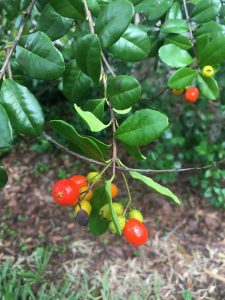Blog by Tina McIntyre and Morgan Pinkerton, UF/IFAS Extension Seminole County
Know native…

To select a native plant, lets first revisit what the term native means! A native plant is a plant that existed within the state boundaries of Florida prior to European contact. There are many benefits to native plants! Native plants do not require fertilizers and use less water, and fewer pesticides than lawns. The deep root systems help prevent erosion and increase the soil’s capacity to store water. Native plants can significantly reduce water runoff and, consequently, flooding, reduce air pollution, do not require mowing, and remove carbon from the air.

Embrace diversity…
Florida’s rich ecological diversity has gifted us with many native plants. Many of these plant species are compatible in the home and commercial landscape! It’s important that we select Florida-Friendly natives because they support robust food webs and a diversity of species. A food web starts with the producers, of which plants are a vast supporter. Native plants are producers that create foliage, flowers, berries, and seeds that are particularly suited for our consumers, Florida’s native animals. Native plants produce nectar, pollen and other appetizing things for our robust insect population. Although many people might not like insects, they pollinate our plants and support the rest of the food web. From the tiny Carolina Wren to the mighty Florida Alligator, this delicate balance starts with native plants.
Investigate invasives…

You can help foster native plants and this delicate cycle in your yard by removing non-native invasive species. Invasive species are species that come from other areas of the world and do not have any natural consumers to keep it in check. They typically do not fit into the web that has existed in our state for hundreds of thousands of years. By removing invasive species and selecting native ones we can reestablish the food web in our communities and enjoy its rich layers.

Experience native…
Perhaps you will be taken away by observing a native Gulf Fritillary Butterfly, Agraulis vanillae coming to lay its eggs on its host, the native Florida Passionflower, Passaflora incarnata. Maybe you will feel extra special as you are awoken by the roosting Florida Barred Owls in the deep of the night as they select your area, rich with prey taking advantage of your native plants. Conceivably you could have baby birds bringing new life to your carport as they break through their delicate shells. Experiences like these are what makes living in Florida special, and planting native plants will help you establish and become a part of this intricate ecosystem.
Selecting for success…

When selecting any plant, including natives, it’s important you know if it is a perennial or annual. Perennials will live several years while annuals typically die after producing seeds within one year. Another good question is how the plant tends to propagate itself. Some of our native wildflowers are great re-seeders, meaning they will develop seeds and plant themselves around your yard. Other native plants prefer to establish in your landscape vegetatively, meaning they will likely grow laterally by their roots. There are many great resources to understand and find these plants for your landscape. Be sure to check out PlantANT, The Florida Association of Native Nurseries (FANN), Native Plant Finder, and Plant Real Florida.
Select native plants because they provide shelter and food for wildlife, promote biodiversity, and encourage stewardship of our natural heritage.
Interested in participating in Weed Wrangle© Week 2021?
Check out this article for more information on what is going on locally this week. Be sure to catch all the other cool resources we are sharing this week on our Central Florida CISMA Facebook page!
More Resources
- Native Plants: An Overview
- Native Plants That Benefit Native Wildlife in the Florida Panhandle
- Recommended Native Landscape Plants for Florida’s Treasure Coast
- Design and Plant a Bee Garden
- USDA Native Gardening
 0
0
